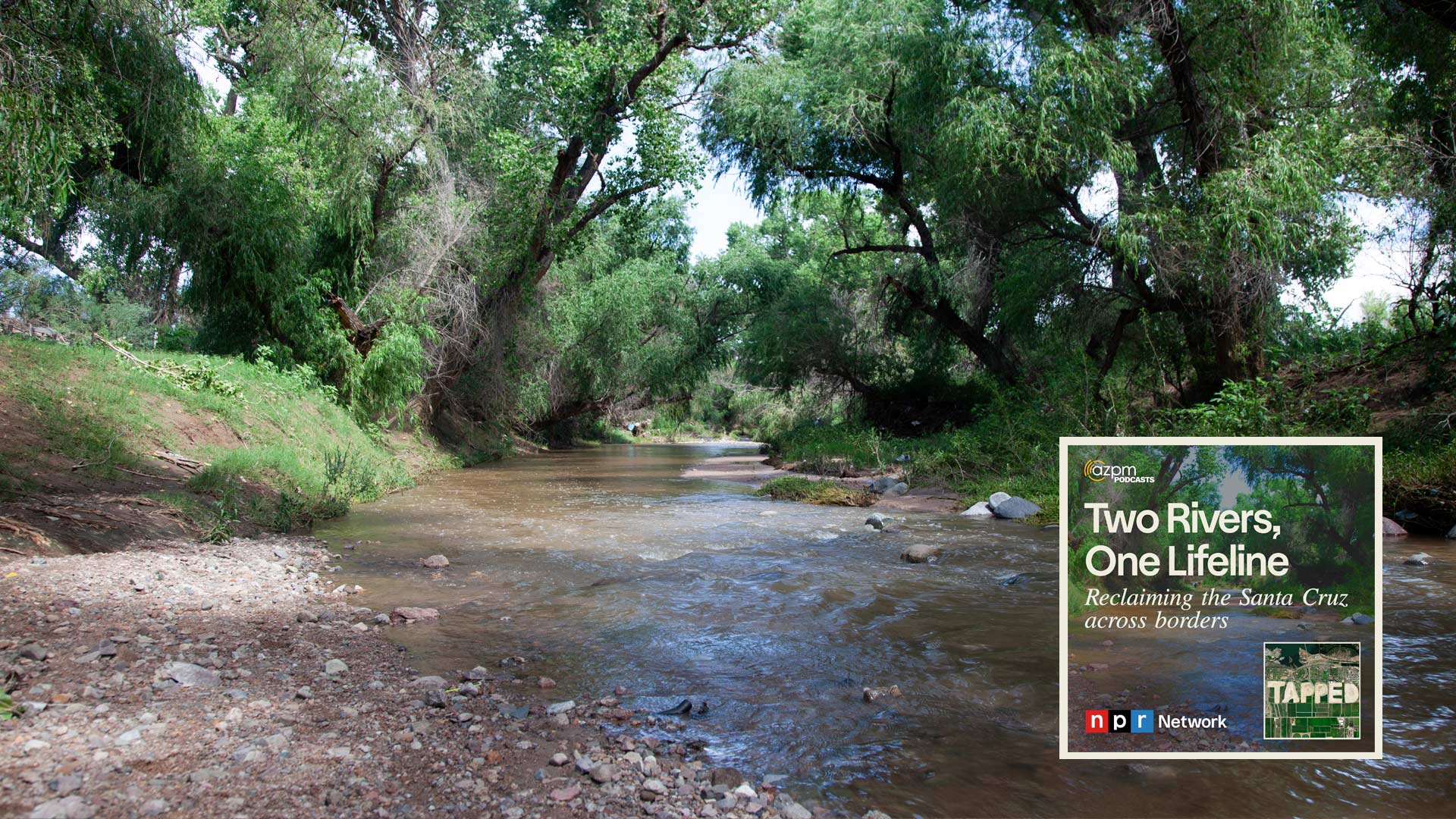 Highly treated wastewater and stormwater flows through the Santa Cruz River off of the Guy Tobin Trailhead in Rio Rico, Ariz., on Thursday, Aug. 1, 2024.
Highly treated wastewater and stormwater flows through the Santa Cruz River off of the Guy Tobin Trailhead in Rio Rico, Ariz., on Thursday, Aug. 1, 2024.
Tapped: Season 3 Episode 05

The Santa Cruz River, which crosses the US-Mexico border twice, was once highly polluted and nearly depleted due to water scarcity, pollution, and over-extraction. However, thanks to binational efforts over the past decade, the river has been cleaned up and partially restored. This episode of Tapped delves into the challenges of managing water across two countries with different regulations and priorities while looking ahead to the much needed infrastructure upgrades to alleviate flooding, which remains a significant threat to the health and safety of the river.
DK: Earlier this year, the Santa Cruz River was designated as one of America’s most endangered rivers.
DK: Water scarcity exacerbated by climate change has impacted the watershed and so has historic pollution and excessive extraction of the aquifer, which has all but depleted the River.
KM: However, the river that crosses the U-S-Mexico border — twice, for that matter — has been cleaned up and recharged, thanks to binational collaboration efforts over the past decade.
KM: People on both sides of the border have been in talks about how to manage flooding.
ZZ: Storm flows that come from Nogales, Sonora cause flooding, and that brings debris, pollutants and sewage into the U-S through the Nogales Wash. And that wash empties into the Santa Cruz River.
 The Nogales Wash in Nogales, Ariz., on Thursday, Aug. 1, 2024. The wash is the main surface water drainage for the Ambos Nogales watershed.
The Nogales Wash in Nogales, Ariz., on Thursday, Aug. 1, 2024. The wash is the main surface water drainage for the Ambos Nogales watershed.ZZ: This is Tapped, a podcast about water. I’m Zac Ziegler.
DK: I’m Danyelle Khmara.
KM: And I’m Katya Mendoza.
ZZ: So how do we clean up a river that passes through two countries with different ideas about how to regulate water?
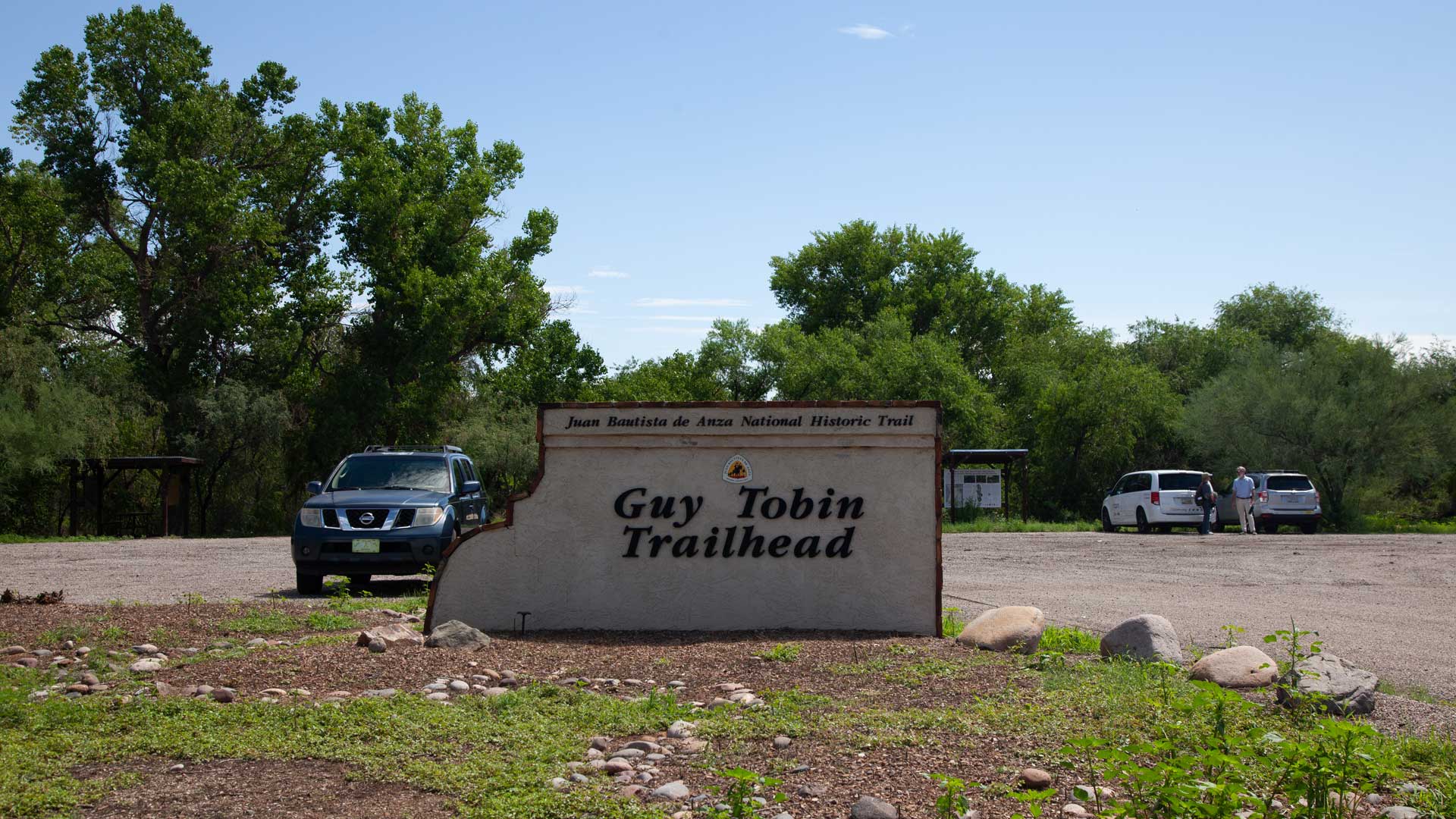 Entrance to the Guy Tobin Trailhead in Rio Rico, Ariz., on Thursday, Aug. 1, 2024. The trailhead leads to the Juan Bautista de Anza National Historic Trail and runs along the Santa Cruz River.
Entrance to the Guy Tobin Trailhead in Rio Rico, Ariz., on Thursday, Aug. 1, 2024. The trailhead leads to the Juan Bautista de Anza National Historic Trail and runs along the Santa Cruz River. ZZ: We've all heard the saying, that two is company but three's a crowd. Well, Danyelle and Katya have worked hard on this story, so they'll take it from here.
[nat sound walking at the Guy Tobin Trailhead]
DK: Steps away from the Guy Tobin trailhead in Rio Rico, on the first day of August, the Santa Cruz River is murky, still settling from recent storms. But it’s inviting nonetheless.
[nat sound of the river]
DK: Just upstream of us to the south is the Nogales International Wastewater Treatment plant. That's where this perennial source of water for the Nogales portion of the Santa Cruz river comes from.
LC: So this water that's flowing by us right now, it's really highly treated wastewater and stormwater, most of which comes across the border through binationally managed infrastructure, and it's treated at that Nogales international wastewater treatment plant to a really high standard. And then it becomes the Santa Cruz River that we're standing next to now.
DK: That’s Luke Cole. He is the director of the Santa Cruz River Program at the Sonoran Institute, an environmental conservation nonprofit.
LC: Cause this river used to be — in the last, let's say, 100 years — kind of something of an open sewer. So why would people be standing 20 feet away from the water like we are now, if it smelled bad and posed health threats? Now, for the most part, this river is just a clean, flowing, beautiful ribbon of water back here in the desert.
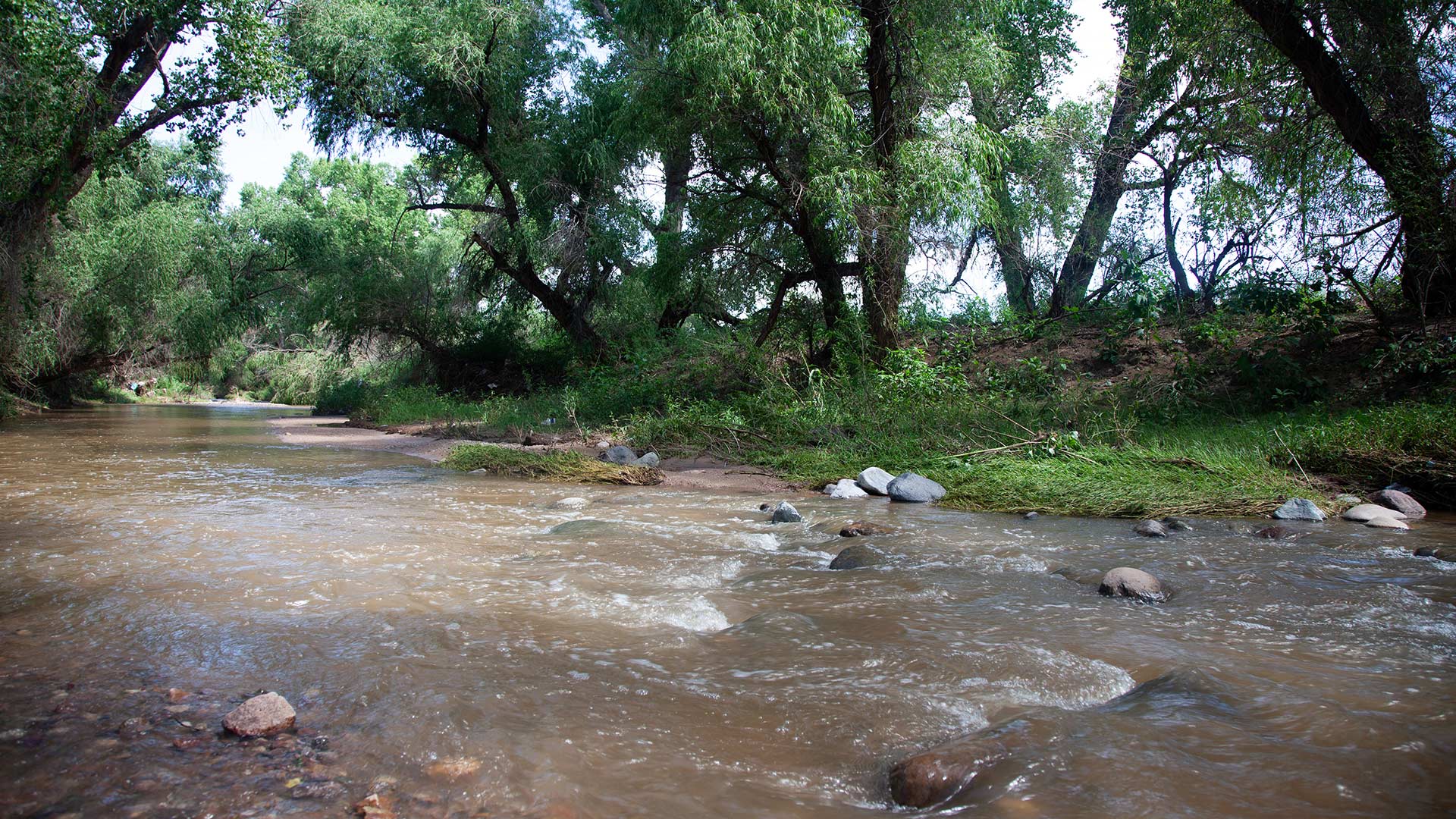 Highly treated wastewater and stormwater flows through the Santa Cruz River off of the Guy Tobin Trailhead in Rio Rico, Ariz., on Thursday, Aug. 1, 2024.
Highly treated wastewater and stormwater flows through the Santa Cruz River off of the Guy Tobin Trailhead in Rio Rico, Ariz., on Thursday, Aug. 1, 2024.
DK: The Santa Cruz is an ephemeral tributary that drains into the Gila River, which then feeds into the Colorado River. It crosses the U.S.-Mexico border twice, starting in the US and heading south, then flowing up from Nogales, Sonora, back up through the Nogales, Arizona, region. Then it flows north to Tucson and beyond, though much of that is just a dry riverbed.
DK: But here in Rio Rico, where the water is flowing, we’re standing above an aquifer of groundwater that runs about 30 feet down to the bedrock below.
LC: Let’s put ourselves back in 2005, about maybe 10 miles to the north of where we are downstream. Sonoran Institute and local partners noticed a major die off of cottonwood trees and we’re standing underneath cottonwood trees right now. Major, almost like a coral bleaching event, seemingly overnight, these cottonwood trees just poof, died out. So Sonoran Institute researchers at the time went down, we did investigations and basically what we found was, even though the Santa Cruz River was flowing, there was a slime layer like a biological cap. Imagine, like a slimy slip and slip and slide that was laying along the bottom of the Santa Cruz River. So that water was moving laterally, was moving downstream just fine. What it wasn’t doing was percolating underground, because that cap prevented water from recharging the groundwater. So these trees like the ones we’re standing under right now, were inches away from their water source, but were not able to get it because of that slime layer, that capping layer of bacteria more or less that was driven by the high amount of nitrogen coming out of the wastewater treatment plant and it’s not specific to this area this was a national thing that was occurring.
DK: Between 2007 and 2008, the Sonoran Institute documented the conditions of the river and shared that information with the federal government.
DK: Luke says the Sonoran Institute has continued to track Santa Cruz River data downstream of that wastewater treatment plant year after year and that the river flowing here is critical for groundwater recharge and water that serves the cities of Ambos Nogales — the collective name for the two Nogales cities on each side of the border. It quite literally means both Nogaleses.
LC: That was sufficient enough to prompt the upgrades to the Nogales International Wastewater Treatment Plant.
KM: Nearly half of Nogales, Sonora’s water comes from the Santa Cruz River Aquifer and a little over 30 percent of it comes from the Los Alisos watershed. The rest comes from the Nogales Aquifer. While on the US side, Nogales uses water from the Santa Cruz and groundwater supplies in the north side of the city.
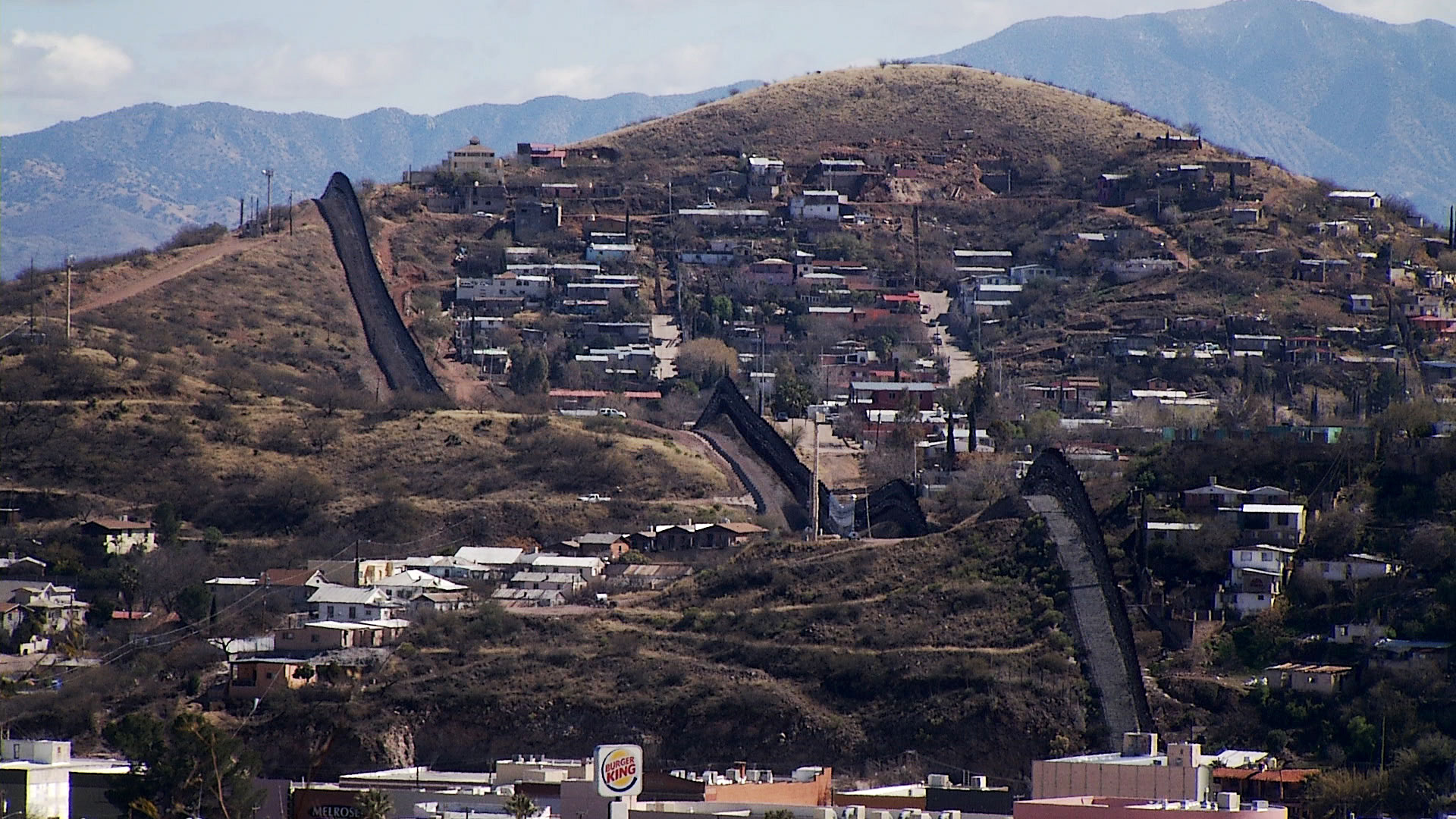 From Nogales, Arizona, a view of the city and its border wall with Nogales, Sonora.
From Nogales, Arizona, a view of the city and its border wall with Nogales, Sonora.
KM: The two cities have a huge disparity in population and growth rate. While the city of Nogales, Arizona, has a population of about 20,000 people, its sister city has an official population of about 200,000. But officials believe that this number has been vastly undercounted and might actually be closer to 350,000.
KM: According to the Water Resources Research Center, “The undercount in population means that Nogales, Sonora, may receive a smaller budget for water provisions and other infrastructure needs as the Mexican federal government bases funding allocation on population estimates.”
KM: Every drop of water counts in the semi-arid region.
ZZ: People will go to added lengths when a commodity is that precious, and for water, that often means cleaning up what we've already used. We'll hear more about that effort after the break.
[mid-show break]
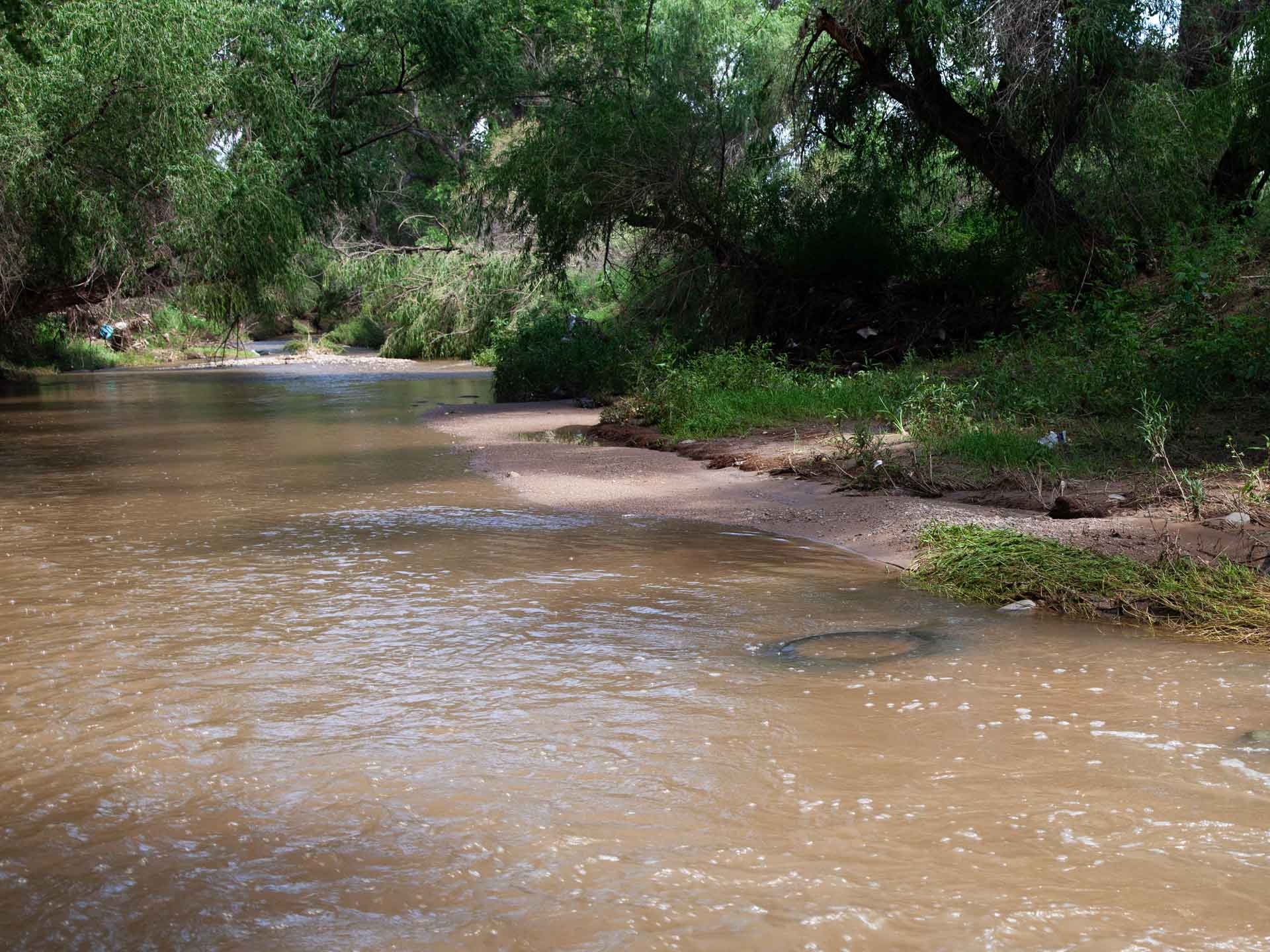 VIEW LARGER A tire stuck in the Santa Cruz River off of the Guy Tobin Trailhead in Rio Rico, Ariz., on Thursday, Aug. 1, 2024. The Sonoran Institute, a conservation organization has installed a passive trash collector to help mitigate the problem of trash as well as to inform potential engineering solutions like bigger trash collectors to prevent trash from moving in the river.
VIEW LARGER A tire stuck in the Santa Cruz River off of the Guy Tobin Trailhead in Rio Rico, Ariz., on Thursday, Aug. 1, 2024. The Sonoran Institute, a conservation organization has installed a passive trash collector to help mitigate the problem of trash as well as to inform potential engineering solutions like bigger trash collectors to prevent trash from moving in the river. ZZ: This is Tapped, a podcast about water. I'm ZZ. Back to Danyelle and Katya's story about the Santa Cruz River, and what it means when water crosses an international border.
DK: Binational water governance and maintenance has its challenges. Besides the great disparity in population and growth, the two cities have different government entities that manage and maintain the water on either side of the border and different standards of quality.
DK: Joaquin Marruffo with the Arizona Department of Environmental Quality says collaboration between Ambos Nogales has evolved in the last 10 years because of the work of local governments on both sides of the border, not just the state and federal governments.
JM: In order to be successful there has to be a local government involvement and very strong relationship between the local governments, because they are the ones that suffer the situations. We at the state level, we know what's going on, but they are there in the battlefield.
DK: Perennial flows on the U-S side of the Santa Cruz are downstream from the Nogales International Wastewater Treatment Plant and are dependent on its effluent discharges.
DK: This water is subject to high variability in flows, due to both wastewater overflows from heavy rainfall and decreases in flow from treatment and discharge of wastewater from the Mexican side.
 VIEW LARGER AZPM border reporter Danyelle Khmara looks at pictures of a mini trash collector that the Sonoran Institute has installed on the Santa Cruz River with Luke Cole, director of the nonprofit's Santa Cruz River Program on Thursday, Aug., 1 2024.
VIEW LARGER AZPM border reporter Danyelle Khmara looks at pictures of a mini trash collector that the Sonoran Institute has installed on the Santa Cruz River with Luke Cole, director of the nonprofit's Santa Cruz River Program on Thursday, Aug., 1 2024. KM: Since the 1950s, wastewater from Nogales, Sonora has been conveyed between Arizona and Sonora by the International Outfall Interceptor pipeline– known as the IOI– a pipeline that begins at the border and provides a perennial surface water source to recharge the groundwater and sustain riparian habitat.
KM: The wastewater is transferred into the Nogales International Wastewater Treatment Plant in Rio Rico, Arizona.
KM: The treatment facility has the capacity of over 14 million gallons of wastewater per day but the total amount can vary depending on the year or season. While 9.9 million gallons are allocated to Nogales, Sonora, the remaining capacity is allocated to cities north of the border, Nogales and Rio Rico.
KM: The plant cannot handle wastewater flows that exceed the 14 million gallons per day for extended periods of time.
DK: What are some of the problems that continue to happen around Santa Cruz in this area? I know that sometimes, if there’s flooding that does cause sewage to get into the water.
LC: The Santa Cruz River down here in what we call the Nogales reach of the river, right? It’s fed from let’s say three sources: rainwater when we get storms, that’s great, rainwater falls like right where we’re standing just gets incorporated right into the river and there it goes. We have the water that is introduced about to the tune of 14 to 15 million gallons a day from the Nogales International Wastewater Treatment Plant. The third source, is a combination of stormwater and wastewater, largely from Nogales, Sonora, that comes into the US through Nogales Wash, which is a tributary to the Santa Cruz River. That water when there are large enough storm events will blend in with the very clean effluent that’s coming out of the wastewater treatment plant and can elevate concentrations of bacteria like E.coli. It can introduce metals, it can introduce nitrogen, in some cases in the form of raw sewage.
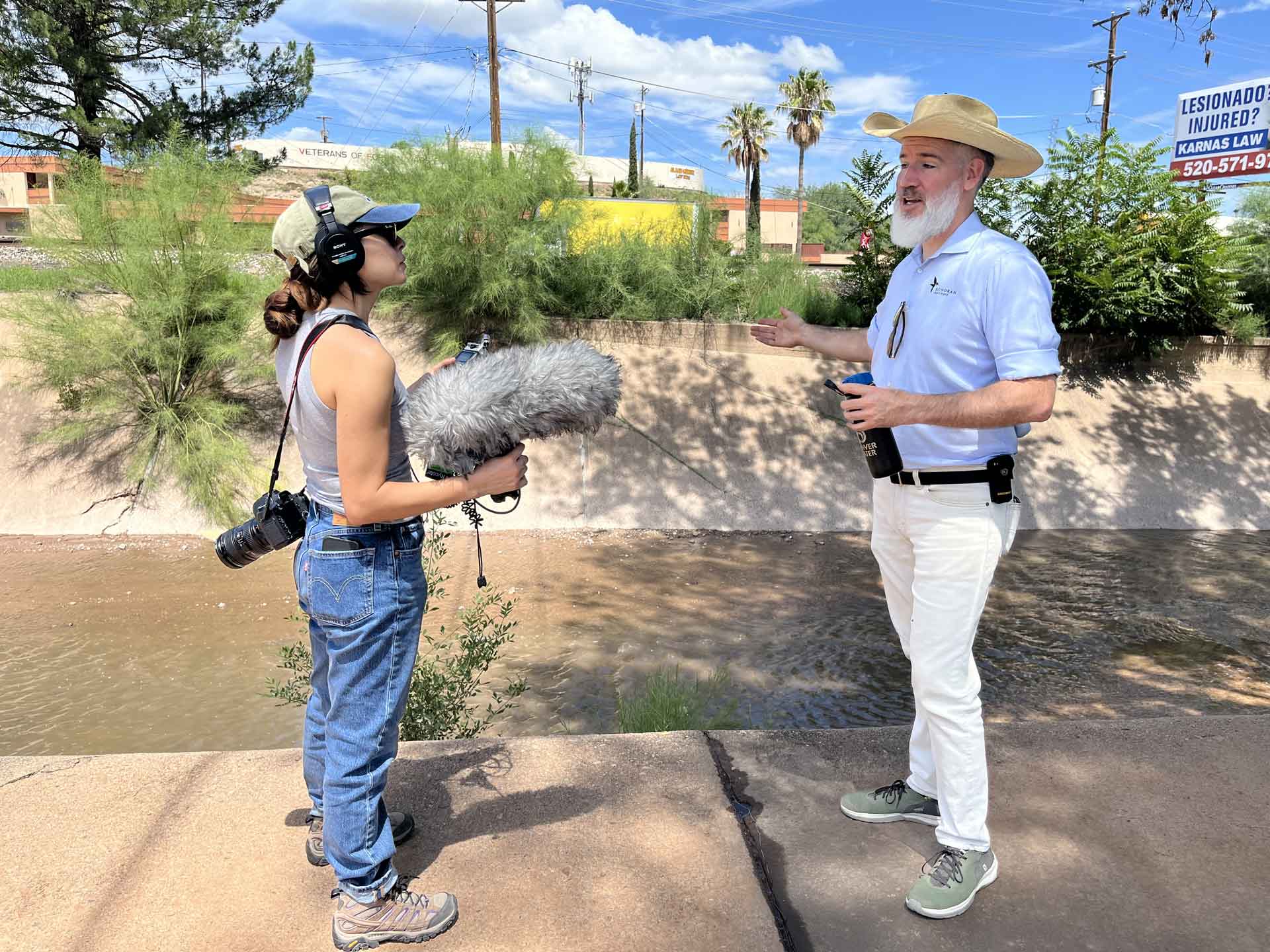 AZPM environmental reporter Katya Mendoza chats with Sonoran Institute's Luke Cole next to the Nogales Wash.
AZPM environmental reporter Katya Mendoza chats with Sonoran Institute's Luke Cole next to the Nogales Wash.
KM: The Wastewater Treatment Plant is the only trans border plant that's on the US side and treats water from both countries. The IOI flows 8.5 miles north to the Nogales treatment plant, concentrating wastewater from Nogales, Sonoran, into a 24 inch pipe that runs about 3 feet below the Nogales Wash.
KM: The reach of the pipeline that was built in 1971 by the U-S International Boundary and Water Commission has developed many cracks since it came online in 1972. Excessive groundwater infiltration has increased the volume in the wastewater system leading to higher than normal operations and maintenance costs for overall treatment.
KM: The wastewater collection system in Sonora, acts like a sanitary-storm water conveyance, however inflow and infiltration of stormwater scours the pipeline in Arizona. There have also been numerous failures of the IOI at the border, like in 2017, when a manhole breach sent millions of gallons of raw sewage into the Santa Cruz River.
 Treated water from the International Outfall Interceptor, a pipeline that carries raw sewage from Nogales, Mexico to a water treatment facility in Rio Rico, Arizona.
Treated water from the International Outfall Interceptor, a pipeline that carries raw sewage from Nogales, Mexico to a water treatment facility in Rio Rico, Arizona.
KM: Here’s a 2018 report from former AZPM reporter Nancy Montoya.
NM: Heavy rains over the past three days are causing concern in Nogales, Arizona, that the sewage pipeline that breached last year will break again. The pipeline is old and in bad shape. John Kissinger is the deputy city manager for Nogales, Arizona.
JK: Is there an environmental disaster waiting to happen? It could. Does sewage, get into the wash, at times? Absolutely.
KM: Repeated failure of the IOI could result in contamination of groundwater resources from industrial and sanitary wastewater infiltrating the aquifer.
KM: The Nogales Wash and IOI are chronically impacted by small flood events that can expose downstream populations to public health risks.
KM: In April, officials completed a long-awaited rehabilitation of the IOI pipeline. But flooding through the Nogales Wash remains an issue.
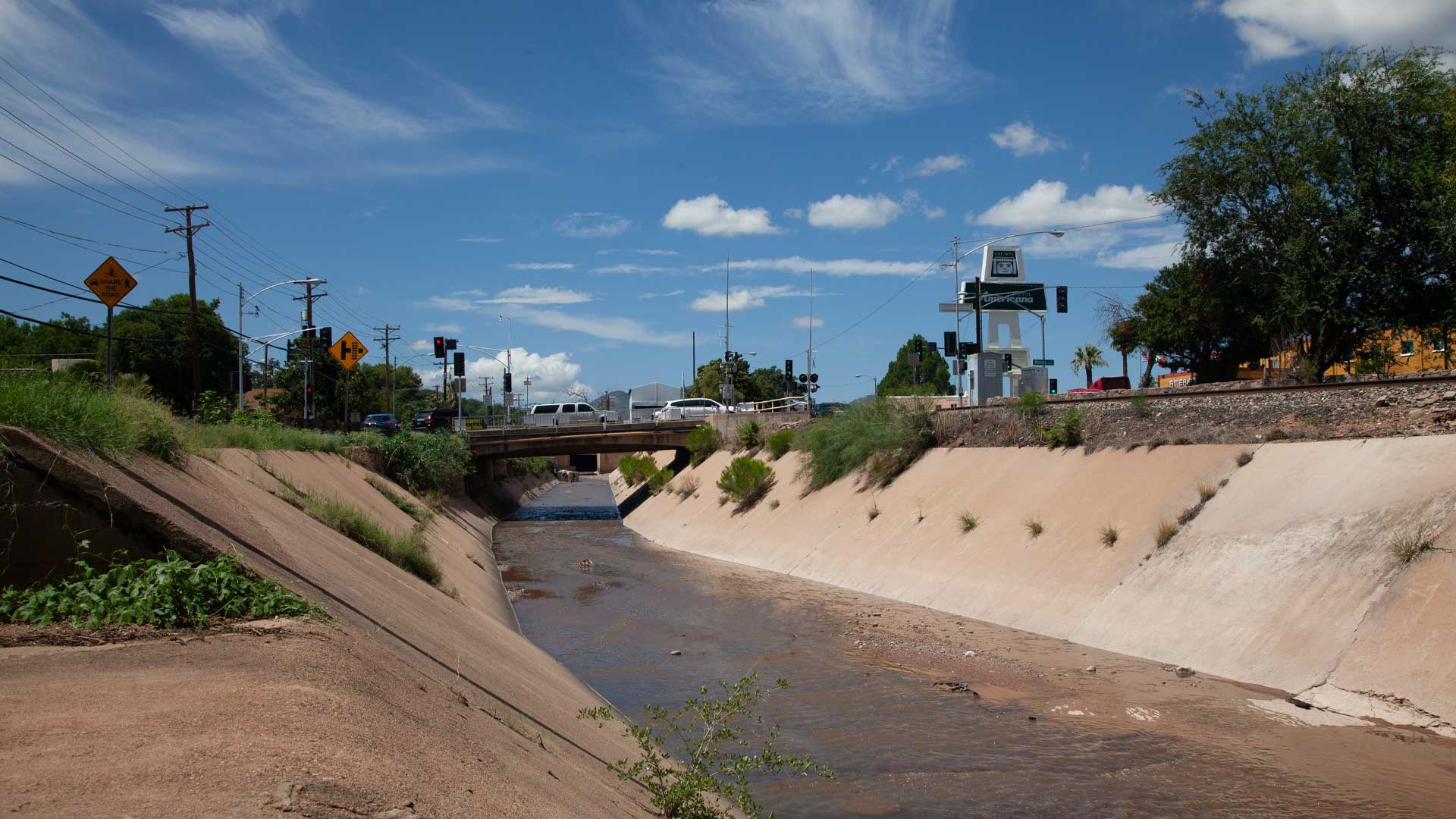 Nogales Wash on Morley Avenue in Nogales, Ariz., on Thursday, Aug. 1, 2024. It is the primary conveyance of stormwater from Nogales, Sonora into the United States.
Nogales Wash on Morley Avenue in Nogales, Ariz., on Thursday, Aug. 1, 2024. It is the primary conveyance of stormwater from Nogales, Sonora into the United States. AB: The real issue that we have is related to flooding, is the debris that comes through the Nogales Wash.
DK: That’s Nogales Public Works Director Alejandro Barcenas.
AB: And that creates an impact on us. We have worked with that and at least highlighted that issue for us and they are aware of that problem, that is a big problem for them.
DK: Barcenas says he thinks they’ve been working in Sonora to better channelize the storm water and alleviate the flooding events, but they haven’t noticed any recent improvements on the US side.
DK: Ambos Nogales has been working for years to address the flooding issues and what that, as a consequence, brings to the Santa Cruz River water quality.
DK: This issue takes a long time to address, because it requires a lot of infrastructure to be built on both sides of the border. Joaquin Marruffo, with the state, and other stakeholders say the most urgent need is investment on the Mexico side of the border. But who pays for this infrastructure that both countries desperately need?
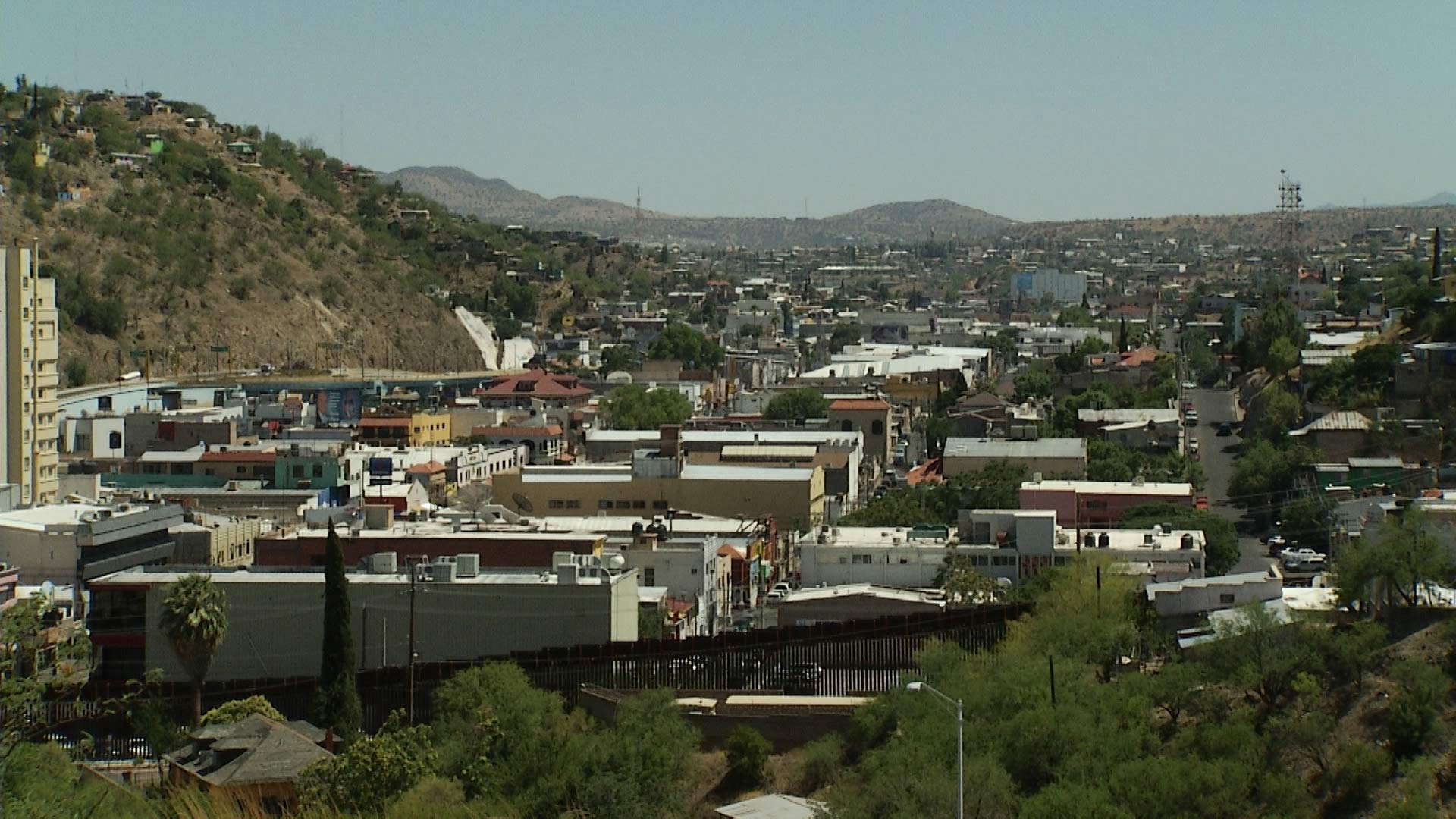 The fence demarcating the division between Nogales, Arizona, and Nogales, Sonora.
The fence demarcating the division between Nogales, Arizona, and Nogales, Sonora.
JM: So that's where the discussion is right now, identifying the sources of funding for these infrastructure to be improved. Next step will be okay, so let's start with the new infrastructure that is required, again…
DK: He added that in the short term, stakeholders are identifying funding sources to improve the operation of existing infrastructure and in the long term, looking for the funding for the new infrastructure that is required on the Mexican side of the border.
DK: Despite the progress that’s been made to clean up the river, solutions to the yearly flooding are still a ways off.
DK: Luke Cole from the Sonoran Institute says decoupling rain water and wastewater needs to happen and would also alleviate flooding.
LC: So, how can we work with our Mexican counterparts to install water capture infrastructure, whether it's green infrastructure or traditional infrastructure, that will hold that water back, allowing that storm water to stay in Mexico, to recharge their diminished aquifers and improve ecological and human health conditions on the Mexican side?
DK: Doing this work — large scale, citywide, region wide, infrastructure work — is a feat in itself. And as far, who will pay for these projects? That, Luke says, is to be determined.
[music fades in]
LC: Bring the stakeholders together, the minds who can imagine what the solutions would look like and the entities that might be able to implement those, with the support of the people who stand to benefit from them. That's the approach that — at least Sonoran Institute, as conveners, as scientists, as a non-political entity — that's the work we're doing, is getting these people all together to help envision the solution and then make them into a reality. We are in the envisioning the solution phase right now, using the best possible data with the best possible partners that we can get.
[music fades out]
[nat sound of the river]
[music fades in]
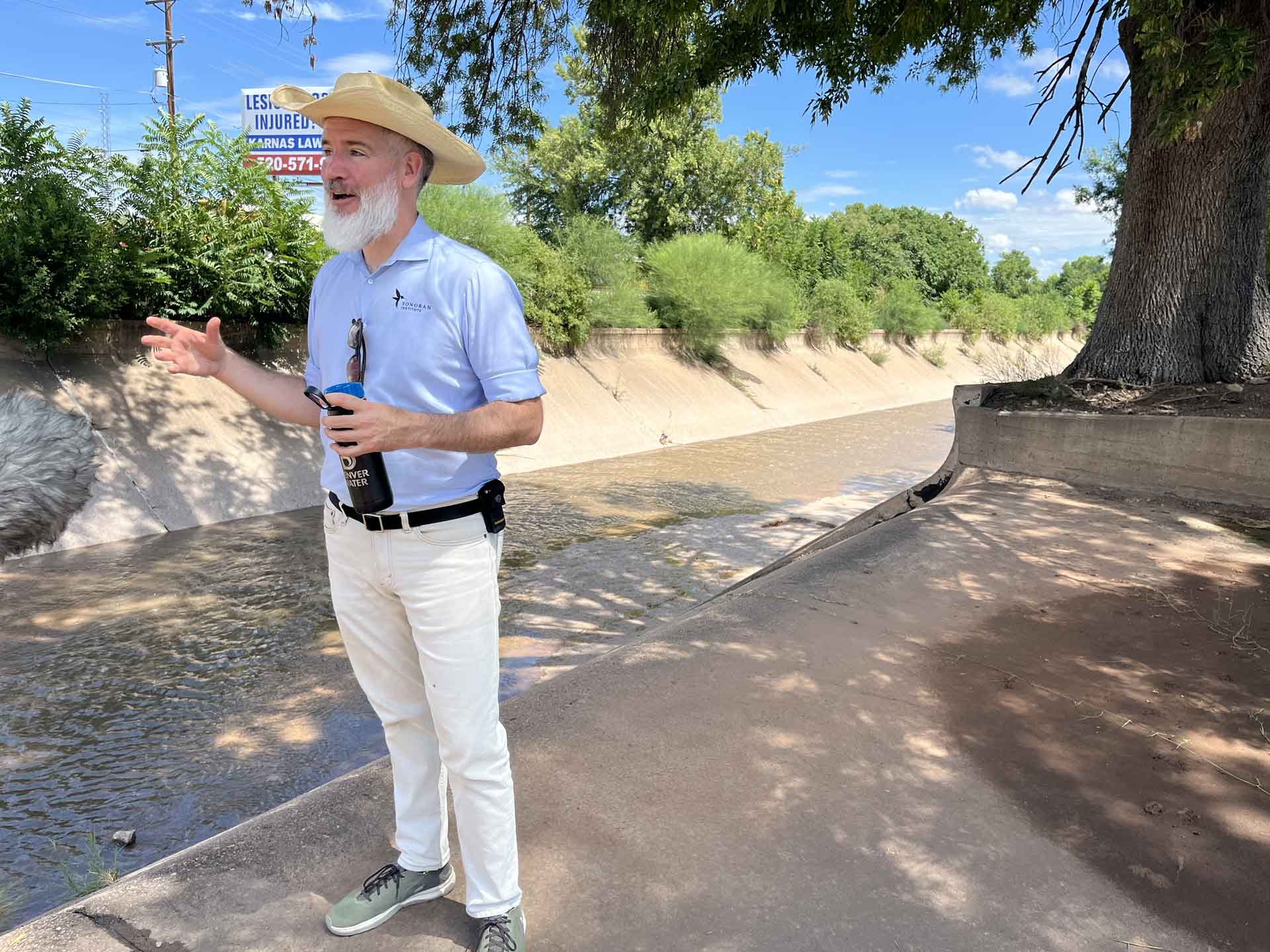
DK: Luke stands next to the Nogales Wash under a huge ash tree, across the street from a little church, a furniture store and a discount plumbing supplies. Just beyond the floodway, with its concrete bottom and sides and shallow flowing water, are the railroad tracks.
DK: When it floods, wastewater and stormwater blend together, and this wash carries it to the Santa Cruz.
[nat sound of traffic near Nogales Wash]
LC: Those things should be separate. The only time you want wastewater and stormwater together is if you have the volume, if you have the infrastructure scaled up to handle both. Here in the border, for the Santa Cruz river, we don't have the infrastructure to handle both. So the most reasonable thing to do, and this is what Sonoran Institute's been researching, is, how do we decouple wastewater and stormwater?
DK: He says that if the wastewater that comes into the US could be separated and fully contained in a separate set of infrastructure from the stormwater, the US could get the wastewater and turn it into water to recharge the Santa Cruz River, and Mexico could keep the stormwater, which could be used for drinking water or other purposes.
LC: Everybody wins. The Santa Cruz river flows. People and wildlife can use it. People in Nogales, Sonora, benefit because they now have more green space, they have more captured storm water, separately captured wastewater. Never the two shall meet. That feels like it's the goal, and it's a new paradigm in this world, compared to a lot of other major municipalities throughout the country. A lot of other major municipalities, they’ve got the huge retention systems to hold wastewater and stormwater and treat them together. We don’t.
[nat sound at the Nogales Wash fades out]
[music fades in]
ZZ: For millennia, humans have used rivers, lakes and other bodies of water as imaginary lines between countries. Some of the earliest civilizations even defined themselves by those bodies. Mesopotamia, a spot in the Middle East that many would argue was the birthplace of agriculture, translates from Greek to mean "between rivers," referring to the Tigres and Euphrates.
But lately, as we start to realize the effects we have on waterways, navigating the differences in priorities between countries can be quite the diplomatic endeavor.
But, sometimes, water and international diplomacy don't just mix at the border. They can cross paths inland. And when it comes to Arizona and one specific country, those efforts date back before either of the governments in that debate technically existed.
That's next time.
Tapped is a production of AZPM News.
This episode was written and reported by Danyelle Khmara and Katya Mendoza with audio mixing by me, Zac Ziegler.
It was edited by our News Director, Christopher Conover.
Our theme music and some interstitial music is by Michael Greenwald.
Visit our website in the podcast section of azpm.org for graphics, links and more.
Thanks for listening.
[music fades out]
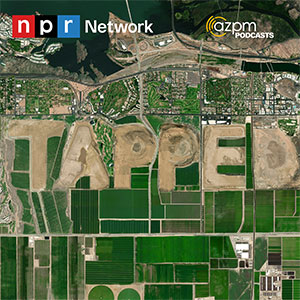





By submitting your comments, you hereby give AZPM the right to post your comments and potentially use them in any other form of media operated by this institution.